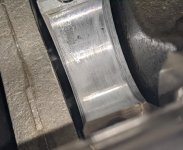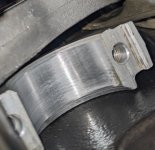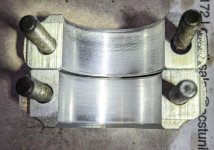You are using an out of date browser. It may not display this or other websites correctly.
You should upgrade or use an alternative browser.
You should upgrade or use an alternative browser.
Export thread
CV740 ... metal shimmer in the oil, 1,500 hours
#1
F
fmorelli
F
fmorelli
I have a CV740-0011 that is about 15 years old. Been in my possession since day one. Mobil 1 oil changes, etc. A few years ago blew a seal. I pulled the motor, regasket, updated parts. The cross hatch looked like new in the cylinders. I thought everything inside looked good. Flattened both heads on a granite calibrated stone. Mower runs great with 100 hours on it since the rebuild.
BUT ... I am seeing metal shimmer in the oil when I dump it. I just dumped oil, ran 20 hours, and now end of season dumped again to inspect. I took a video for a buddy to ask questions: https://photos.app.goo.gl/673M4EH4H4F3KmFm6
I'm assuming rod or crank bearings on their way out. Should I just pull the engine, replace rod and crank bearings with std size, and keep on trucking? (I guess I'm asking, on these mowers, is this generally ok at this stage). Assuming nothing has spun of course (which I doubt). Or ... ? Would appreciate any feedback!
BUT ... I am seeing metal shimmer in the oil when I dump it. I just dumped oil, ran 20 hours, and now end of season dumped again to inspect. I took a video for a buddy to ask questions: https://photos.app.goo.gl/673M4EH4H4F3KmFm6
I'm assuming rod or crank bearings on their way out. Should I just pull the engine, replace rod and crank bearings with std size, and keep on trucking? (I guess I'm asking, on these mowers, is this generally ok at this stage). Assuming nothing has spun of course (which I doubt). Or ... ? Would appreciate any feedback!
#2

Scrubcadet10
Scrubcadet10
Do you have the Spec number of the engine? CV742-xxxx
No bearings on this engine, except for maybe a ball bearing in the PTO side (rarely).
What parts did you replace?
No bearings on this engine, except for maybe a ball bearing in the PTO side (rarely).
What parts did you replace?
#3
B
bertsmobile1
B
bertsmobile1
your assumptions are correct, some thing is grinding away meal
So 2 options, run it till it goes bang then blame the synthetic oil which of course means the mower should run for a million hours with no wear.
Or pull it apart right now & look for the source thus potentially saving the short block
It could need nothing more than a thrust washer between the crank & the sump or of course, the crank or cam could be wearing the bush area oval.
When you replace a seal you need to be very careful not to drive them in too deep & partially block off oil feed holes .
So 2 options, run it till it goes bang then blame the synthetic oil which of course means the mower should run for a million hours with no wear.
Or pull it apart right now & look for the source thus potentially saving the short block
It could need nothing more than a thrust washer between the crank & the sump or of course, the crank or cam could be wearing the bush area oval.
When you replace a seal you need to be very careful not to drive them in too deep & partially block off oil feed holes .
#4
F
fmorelli
Parts change - regasket and seals. A few external updated parts (like oil breather plate if I recall). Nothing internal was replaced.
I looked at the Kohler parts diagrams and yeah ... no rod bearings or crank bearings in the diagram. No bearing on the PTO side? It's been a couple years and I don't remember the innards any more. I did not remove the rods/pistons/crank. How does this stuff work without bearings?! lol
That leaves me head scratching on the metal. I'm a car guy so not sure how the smaller engine stuff goes - I would have guess rod or crank bearings ... but, per se, those aren't here best as I can tell? Thanks for any insights....
It runs great (don't they always before they go ka-boom?!) ... I just finished my last mow and am trying to be proactive (i.e. if I need to do something, then winter is a good time for that).
F
fmorelli
Original motor is a CV740-0011 (in a Gravely PM260Z 992047). Kohler's updated motor would be a CV742-3023.Do you have the Spec number of the engine? CV742-xxxx
No bearings on this engine, except for maybe a ball bearing in the PTO side (rarely).
What parts did you replace?
Parts change - regasket and seals. A few external updated parts (like oil breather plate if I recall). Nothing internal was replaced.
I looked at the Kohler parts diagrams and yeah ... no rod bearings or crank bearings in the diagram. No bearing on the PTO side? It's been a couple years and I don't remember the innards any more. I did not remove the rods/pistons/crank. How does this stuff work without bearings?! lol
That leaves me head scratching on the metal. I'm a car guy so not sure how the smaller engine stuff goes - I would have guess rod or crank bearings ... but, per se, those aren't here best as I can tell? Thanks for any insights....
It runs great (don't they always before they go ka-boom?!) ... I just finished my last mow and am trying to be proactive (i.e. if I need to do something, then winter is a good time for that).
#5
B
bertsmobile1
B
bertsmobile1
Aluminium is an excellent bearing material
Most cams run direct in the head with no bushes.
Works fine so long as the oil supply is good & the oil is clean.
Most cams run direct in the head with no bushes.
Works fine so long as the oil supply is good & the oil is clean.
#6
F
fmorelli
F
fmorelli
Again I don't have experience with these motors. Is this something that can continue to run fine for a few hundred hours, or will it grenade quickly when it starts to show glitter in the oil? Thanks.
#7

Scrubcadet10
Scrubcadet10
Could get an oil analysis for $30, https://www.blackstone-labs.com/tests/standard-analysis/
They can tell you what the metals are specifically and what they may be..
FWIW, i've been using a briggs push mower with a rattle coming from what sounds like the connecting rod for about 6 years now, every mowing season for about 30 minutes each week.
here's a sample
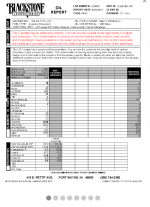
They can tell you what the metals are specifically and what they may be..
FWIW, i've been using a briggs push mower with a rattle coming from what sounds like the connecting rod for about 6 years now, every mowing season for about 30 minutes each week.
here's a sample

#8
B
bertsmobile1
B
bertsmobile1
Put it this way
That short block is $ 800
A single con rod is $ 50
There are 2 oversizes available do you should be able to run that engine for the next 50 years
Bugger the top crank or cam journals and the engine is toast .
Pulling the sump off to check will cost nothing but a lower oil seal & sump gasket .
Only you know what sort of money you have availible
I am always one for finding out the problem first then working out what you are going to do
If for instance all that has happened is the seal was driven in too far then a new seal might be the fix or a new sump cover.
Kohler have their service manuals on line
However the last time I tried to download one I was blocked but I did get one from OPE .
So download your service manual, flip through it and see if you are comfortable with what is required.
That short block is $ 800
A single con rod is $ 50
There are 2 oversizes available do you should be able to run that engine for the next 50 years
Bugger the top crank or cam journals and the engine is toast .
Pulling the sump off to check will cost nothing but a lower oil seal & sump gasket .
Only you know what sort of money you have availible
I am always one for finding out the problem first then working out what you are going to do
If for instance all that has happened is the seal was driven in too far then a new seal might be the fix or a new sump cover.
Kohler have their service manuals on line
However the last time I tried to download one I was blocked but I did get one from OPE .
So download your service manual, flip through it and see if you are comfortable with what is required.
#9
A
andyboy
A
andyboy
Once a penguin went into a mower repair place with the same original problem.
The mechanic said, "It looks like you blew a seal".
The penguin replied, "No, I just had a milkshake".
The mechanic said, "It looks like you blew a seal".
The penguin replied, "No, I just had a milkshake".
#10
A
Ariens A19A42
A
Ariens A19A42
I only run Amsoil Z-ROD oil which has a high content of anti wear Zinc in it. The Zinc totally saves the cam, bearings, cylinder walls ect ect from pre mature wear. Its made for hot rods and vintage cars but I run it in all my mowers and even new cars. Even new cars. If your car or motor does not burn a lot of oil it is perfectly safe for the cars cat and smog system. Inside of all my mower motors look brand new and my cars that have 100k plus miles look brand new. They run nice and smooth and quite..I have a CV742 that is about 15 years old. Been in my possession since day one. Mobil 1 oil changes, etc. A few years ago blew a seal. I pulled the motor, regasket, updated parts. The cross hatch looked like new in the cylinders. I thought everything inside looked good. Flattened both heads on a granite calibrated stone. Mower runs great with 100 hours on it since the rebuild.
BUT ... I am seeing metal shimmer in the oil when I dump it. I just dumped oil, ran 20 hours, and now end of season dumped again to inspect. I took a video for a buddy to ask questions: https://photos.app.goo.gl/673M4EH4H4F3KmFm6
I'm assuming rod or crank bearings on their way out. Should I just pull the engine, replace rod and crank bearings with std size, and keep on trucking? (I guess I'm asking, on these mowers, is this generally ok at this stage). Assuming nothing has spun of course (which I doubt). Or ... ? Would appreciate any feedback!
#11

VRR.DYNDNS>BIZ
VRR.DYNDNS>BIZ
Good advise here. I would add, only generally 2 metals , ie aluminum or steel, magnetic or not. Additionally, I do not think synthetic an ideal oil for these engines except maybe I might agree for recent 2-3 year production where fits and finishes are better for synthetic. The size of the metal specs indicate most likely from gear train or something recent rather than long term. Do you change the oil filter which should collect this stuff from circulation. That also makes the oil seal press depth a question effecting filtration/circulation.Put it this way
That short block is $ 800
A single con rod is $ 50
There are 2 oversizes available do you should be able to run that engine for the next 50 years
Bugger the top crank or cam journals and the engine is toast .
Pulling the sump off to check will cost nothing but a lower oil seal & sump gasket .
Only you know what sort of money you have availible
I am always one for finding out the problem first then working out what you are going to do
If for instance all that has happened is the seal was driven in too far then a new seal might be the fix or a new sump cover.
Kohler have their service manuals on line
However the last time I tried to download one I was blocked but I did get one from OPE .
So download your service manual, flip through it and see if you are comfortable with what is required.
#12
B
bertsmobile1
B
bertsmobile1
Oil flow to the big end is via the bottom bush and often via the space between the oil seal & the crank
The corner of the machines out area has an oil supply hole
If the seal is pressed in too ar you can block off this hole by about 2/3 thus drastically reducing the oil flow.
Some older engines has a step to seat the seal to but most now days the hole is the sam diameter all the way down..
Governors and automatic decompressors have a habit of falling apart and munching up things.
Right now the only cost for having a look is time , a gasket & a seal
The longer you take the worse it will get
Your mower your decision.
The corner of the machines out area has an oil supply hole
If the seal is pressed in too ar you can block off this hole by about 2/3 thus drastically reducing the oil flow.
Some older engines has a step to seat the seal to but most now days the hole is the sam diameter all the way down..
Governors and automatic decompressors have a habit of falling apart and munching up things.
Right now the only cost for having a look is time , a gasket & a seal
The longer you take the worse it will get
Your mower your decision.
#13
F
fmorelli
Just for context again, when I had regasket the motor @ 1,400 hours, I did not remove the crank/rods/pistons. Hatch looked great in the cylinders. Oil at that time was clean and didn't indicate a need to do more. I simply leveled heads, seated valves with paste, and all new/updated gaskets everywhere. Runs well, burns some oil on start. It has 1,500 hours now (+100 hrs since regasket).
I can see little aluminum flake evidence on the camshaft wheel.
Nothing obvious to take pictures of and share. Any suggestions?
F
fmorelli
Alright got the mower out and on the bench today. Pulled the pan. The oil seal is about 1/8" prior to the oil feed, so there is no obstruction. Off-hand I don't see anything obvious though I have not done more disassembly beyond pulling the crankshaft (looks fine).Oil flow to the big end is via the bottom bush and often via the space between the oil seal & the crank
The corner of the machines out area has an oil supply hole
If the seal is pressed in too ar you can block off this hole by about 2/3 thus drastically reducing the oil flow.
Some older engines has a step to seat the seal to but most now days the hole is the sam diameter all the way down..
Governors and automatic decompressors have a habit of falling apart and munching up things.
Right now the only cost for having a look is time , a gasket & a seal
The longer you take the worse it will get
Your mower your decision.
Just for context again, when I had regasket the motor @ 1,400 hours, I did not remove the crank/rods/pistons. Hatch looked great in the cylinders. Oil at that time was clean and didn't indicate a need to do more. I simply leveled heads, seated valves with paste, and all new/updated gaskets everywhere. Runs well, burns some oil on start. It has 1,500 hours now (+100 hrs since regasket).
I can see little aluminum flake evidence on the camshaft wheel.
Nothing obvious to take pictures of and share. Any suggestions?
#14

Scrubcadet10
Scrubcadet10
I hope you cleaned the engine cleaner than Mr.Cleans cleanest room in his house, that valve grinding compound will get anywhere in that engine.
#15
F
fmorelli
F
fmorelli
Absolutely did. I have a lot of automotive experience; just not small engine.I hope you cleaned the engine cleaner than Mr.Cleans cleanest room in his house, that valve grinding compound will get anywhere in that engine.
#16
F
fmorelli
F
fmorelli
Adding some photos. Best as I can tell all these surfaces look just fine. Note I have a photo of the camshaft gear and you can see small aluminum glitter on it. Last two photos show the oiling hole is clear.
Anyone see any issues in these photos that I'm missing? Do I need to pull the heads and rods next? I don't know if I've got a rod bearing surface being eaten up.
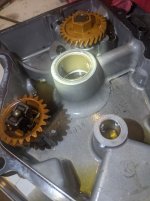
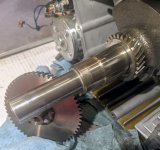
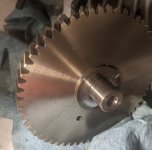
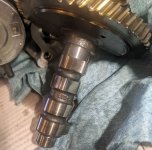
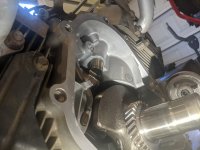

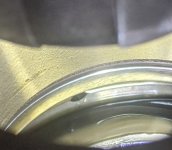
Anyone see any issues in these photos that I'm missing? Do I need to pull the heads and rods next? I don't know if I've got a rod bearing surface being eaten up.







#17
3
350Rocket
3
350Rocket
I'm not seeing anything bad. Sure looks clean. At least you got a lot of hours out of it for a modern small engine. Hard to say whether you should dig deeper or just cross your fingers that it keeps going for a while.
#18
F
fmorelli
I'm wondering if the top side of the case/crankshaft can have a problem. Other than that, the only remaining place I think could be an issue is one of the rods at the large end?
That's why I've asked ... before I decide to take the whole motor apart. I feel like I'm chasing a ghost.
F
fmorelli
Clean most likely due to Mobil 1 being used since new with <100 hour oil changes. My experience is that synthetic oil motors just look cleaner inside.I'm not seeing anything bad. Sure looks clean. At least you got a lot of hours out of it for a modern small engine. Hard to say whether you should dig deeper or just cross your fingers that it keeps going for a while.
I'm wondering if the top side of the case/crankshaft can have a problem. Other than that, the only remaining place I think could be an issue is one of the rods at the large end?
That's why I've asked ... before I decide to take the whole motor apart. I feel like I'm chasing a ghost.
#19

peteco
peteco
I think it's aluminium ( from Photo 1 and 6) try a magnet test, may be when you reassemble a little dirt stay inside and do the job. Wash and clean it all and reassemble. No ghost, only mysteries
#22
R
Rivets
R
Rivets
Definitely see wear on both halves of the rod bearings. Probably the source of your glitter. If I had it in my shop I would be replacing the rod. Everything else looks fine to me. Just my opinion.
#23
F
fmorelli
I guess I'm pulling the heads so I can get these assemblies out, then, and change out the rods. Thanks for the feedback!
F
fmorelli
General consensus that I got from two other engine guys I know (though automotive).Definitely see wear on both halves of the rod bearings. Probably the source of your glitter. If I had it in my shop I would be replacing the rod. Everything else looks fine to me. Just my opinion.
I guess I'm pulling the heads so I can get these assemblies out, then, and change out the rods. Thanks for the feedback!
#24
B
bertsmobile1
B
bertsmobile1
I would go one step further than Rivets and give to journal a quick light polish with Silvro , Dilute tooth paste or similar fine abrasive .
As all of the damage is on one side of the rod pay close attention to that side of the journal
As all of the damage is on one side of the rod pay close attention to that side of the journal
#25
F
fmorelli




F
fmorelli
Wanted to update this post. I replaced the rods with new. When I removed the crank I found the flywheel side of the crank bearing surface in the upper case was probably the aluminum culprit. I've attached some photos. I carefully cleaned it up (last two photos). I did not check clearance because, simply, at this point it runs until it hits the trash can so it doesn't matter.
Everything went back together, new gaskets. I decided to move to 5w-50 for a bit of viscosity help on the hot side.
Motor sounds great and is running well. We'll see how long it lasts - we're at 1,500 hours currently.
Why is there wear up here? I don't know as a fact. Oil does need to be pumped up to this bearing surface. Maybe oil ran low at some point. I was careful on setting the new upper crank seal (replacing the original factory installed seal).
Everything went back together, new gaskets. I decided to move to 5w-50 for a bit of viscosity help on the hot side.
Motor sounds great and is running well. We'll see how long it lasts - we're at 1,500 hours currently.
Why is there wear up here? I don't know as a fact. Oil does need to be pumped up to this bearing surface. Maybe oil ran low at some point. I was careful on setting the new upper crank seal (replacing the original factory installed seal).

